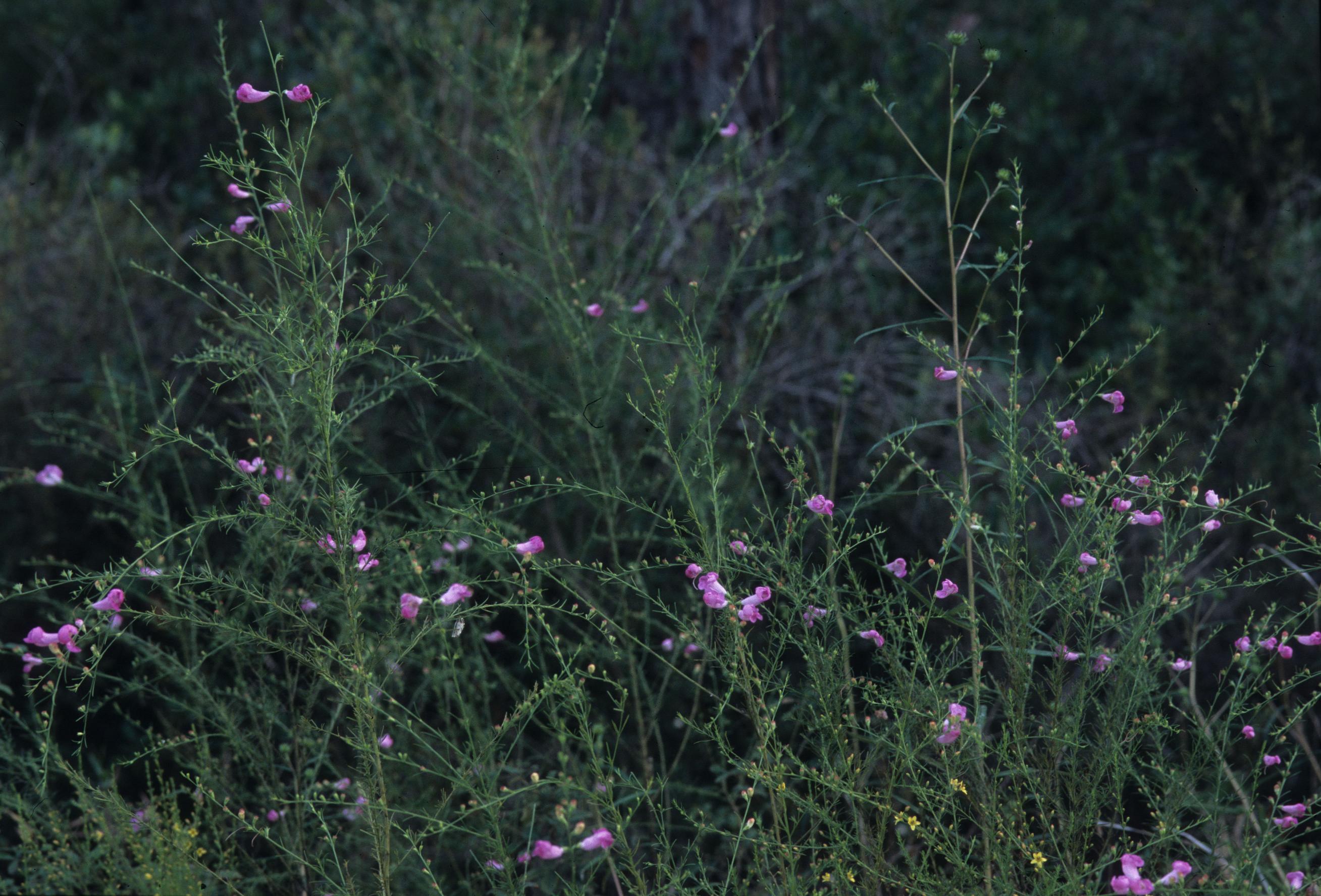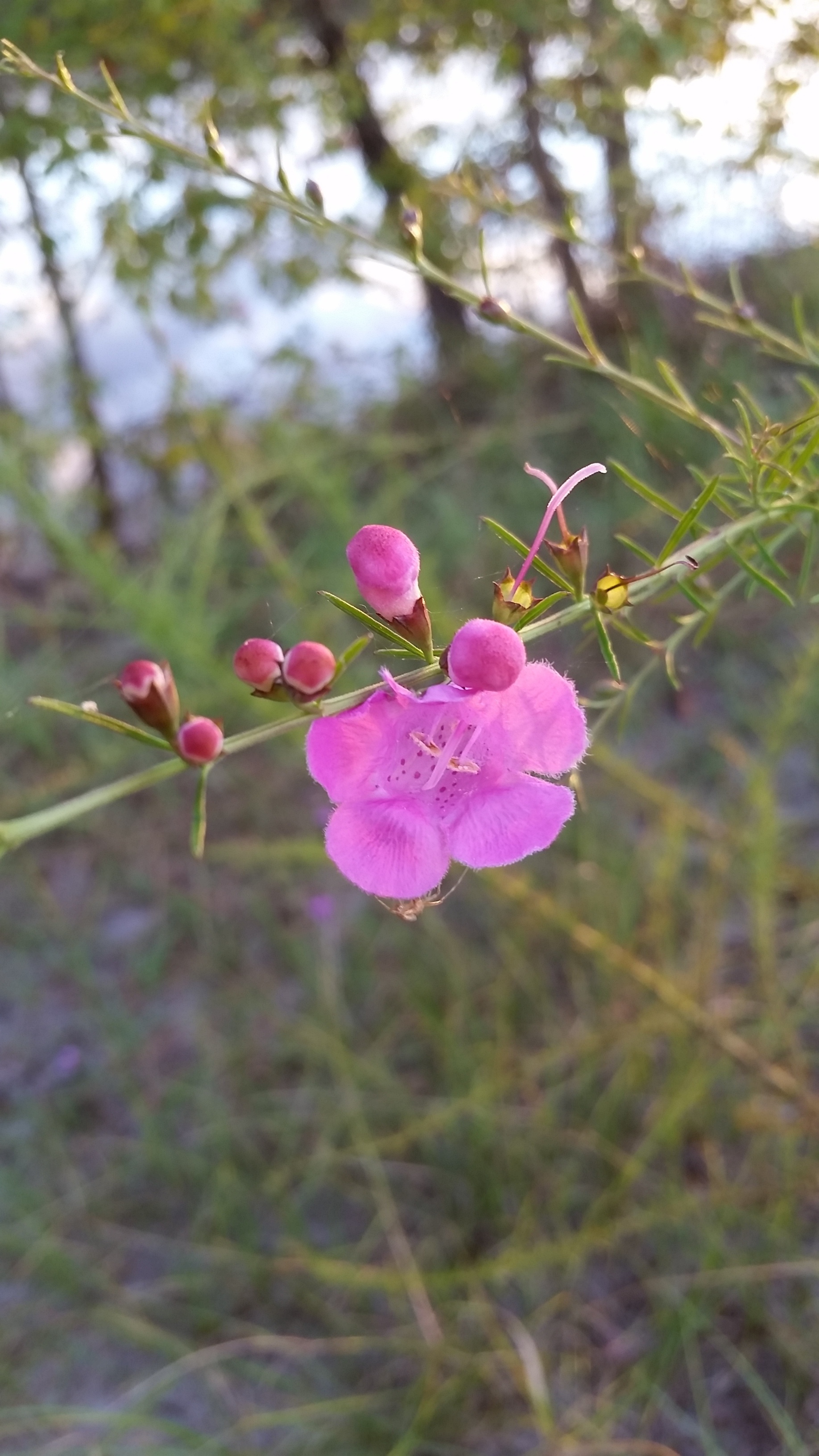Difference between revisions of "Agalinis fasciculata"
KatieMccoy (talk | contribs) |
KatieMccoy (talk | contribs) (→Distribution) |
||
| Line 29: | Line 29: | ||
==Distribution== | ==Distribution== | ||
| − | It is common in all of Florida. Found from: west to Texas, north to North Carolina | + | It is common in all of Florida. Found from: west to Texas, north to North Carolina<ref name="hall"/>. |
==Ecology== | ==Ecology== | ||
Revision as of 19:33, 21 March 2016
| Agalinis fasciculata | |
|---|---|

| |
| Photo was taken by Gil Nelson | |
| Scientific classification | |
| Kingdom: | Plantae |
| Division: | Magnoliophyta - Flowering plants |
| Class: | Magnoliopsida - Dicotyledons |
| Order: | Lamiales |
| Family: | Orobancheaceae |
| Genus: | Agalinis |
| Species: | A. fasciculata |
| Binomial name | |
| Agalinis fasciculata (Elliott) Raf. | |

| |
| Natural range of Agalinis fasciculata from USDA NRCS Plants Database. | |
Common names: Beach False Foxglove; Cluster-leaf Gerardia
Contents
Taxonomic notes
Synonym names: Gerardia fasciculata Elliott; A. fasciculata (Elliott) Rafinesque; Gerardia fasciculata ssp. typica – P; Gerardia fasciculata ssp. peninsularis (Pennell) Pennell
Description
Annual. Parasitic to the roots of grasses and other herbs. Leaves are opposite, linear to filiform, and sometimes will have tufts on the shoots. Flowers are showy, in terminal racemes; the calyx is 5-parted, the lobes are shorter than the tube; the corolla is 5-parted. The flowers are rose-lavender in color and are rarely white. There are usually 2 yellow lines and numerous purple spots in the throat on the tube. The tube is broad, campanulate, and the lobes are shorter than the tube. The throat is usually lanose at the base of the 2 upper corolla lobes. There are 4 stamens, didynamous, that include filaments and anthers that are also lanose. The stigmas are elongated. The capsules are globose or subglobose, loculicidal[1].
The stems are similar to Agalinis purpurea, but instead are scabrous to scaberulous (not puberulent). Flowers August to October[1].
Distribution
It is common in all of Florida. Found from: west to Texas, north to North Carolina[2].
Ecology
Habitat
It can be found in frequently burned pine sandhills (Entisols), flatwoods (Spodosols), upland pine communities and shortleaf pine-oak-hickory woodlands (Ultisols), as well as calcareous glades, sandhills, coastal scrubs, margins of ponds, lakes, depressions, marshes, and wet meadows, and on the borders of dunes[1][3][4]. It occurs on a wide range of soil types from deep sands to loamy clay. It requires high light provided by frequently burned areas. It can occur on very disturbed soils, such those in railroad and power line rights-of-way, clear-cut areas, disturbed roadsides, dredged up sand, and site-prepped pine forests. It appears to be somewhat salt tolerant given its proximity to salt marshes and co-existence with Spartina bakari and other brackish-salt water plants[4][3].
Associated species includes Bidens, Chrysopsis, Eupatorium, Schoenus nigricans, A. longespica, Houstonia nigricans, Rynchospora divergens, Scleria verticillata, Juniperus, Haplopappus, Rubus, Gnaphaluim, Eupatorium compositifolium, Baccharis, Andropogon, Xyris, Polygala, Solidago, Trichostema, Spartina bakeri, Myrica cerifera, Euthamia minor, Baccharis angustfolia, Hyptis, Lycopus, Drosera, and Pinus palustris[3] .
Phenology
Fall flowering (Flowering Specimens of Species at FSU's Robert K. Godfrey Herbarium, Thumbnails of all Specimens of Species at Valdosta State University Herbarium).
It flowers summer to fall; however in the southern peninsula of Florida, it can flower all year[5]. Numerous small capsules each carrying hundreds of brown honeycombed seeds mature in late autumn[4].
Michelle Smith observed Agalinis fasciculata flowering along Piney Z Lake in Tallahassee, Florida in September 2015 & flowering at Pebble Hill Plantation in Grady County, GA in October 2015.
Pollination
The following Hymenoptera families and species were observed visiting flowers of Agalinis fasciculata at Archbold Biological Station (Deyrup 2015):
Colletidae: Hylaeus confluens
Halictidae: Augochlorella gratiosa
Megachilidae: Megachile albitarsis
Conservation and Management
Cultivation and restoration
Photo Gallery
References and notes
Florida State University Robert K. Godfrey Herbarium database. URL: http://herbarium.bio.fsu.edu/
Deyrup, M.A. 2015. Database of observations of Hymenoptera visitations to flowering plants on Archbold Biological Station, Florida, USA.
Hall, David W. Illustrated Plants of Florida and the Coastal Plain: based on the collections of Leland and Lucy Baltzell. 1993. A Maupin House Book. Gainesville. 341. Print.
Musselman, L. J. and W. F. Mann, Jr (1979). "Agalinis fasciculata (Scrophulariaceae), a native parasitic weed on commercial tree species in the southeastern United States." American Midland Naturalist 101: 459-464.
Radford, Albert E., Harry E. Ahles, and C. Ritchie Bell. Manual of the Vascular Flora of the Carolinas. 1964, 1968. The University of North Carolina Press. 960. Print.
Wunderlin, Richard P. and Bruce F. Hansen. Guide to the Vascular Plants of Florida. Second edition. 2003. University Press of Florida: Gainesville/Tallahassee/Tampa/Boca Raton/Pensacola/Orlando/Miami/Jacksonville/Ft. Myers. 546. Print.
- ↑ 1.0 1.1 1.2 Radford, Albert E., Harry E. Ahles, and C. Ritchie Bell. Manual of the Vascular Flora of the Carolinas. 1964, 1968. The University of North Carolina Press. 960. Print.
- ↑ Cite error: Invalid
<ref>tag; no text was provided for refs namedhall - ↑ 3.0 3.1 3.2 Florida State University Robert K. Godfrey Herbarium database. URL: http://herbarium.bio.fsu.edu/
- ↑ 4.0 4.1 4.2 Musselman, L. J. and W. F. Mann, Jr (1979). "Agalinis fasciculata (Scrophulariaceae), a native parasitic weed on commercial tree species in the southeastern United States." American Midland Naturalist 101: 459-464.
- ↑ Wunderlin, Richard P. and Bruce F. Hansen. Guide to the Vascular Plants of Florida. Second edition. 2003. University Press of Florida: Gainesville/Tallahassee/Tampa/Boca Raton/Pensacola/Orlando/Miami/Jacksonville/Ft. Myers. 546. Print.

